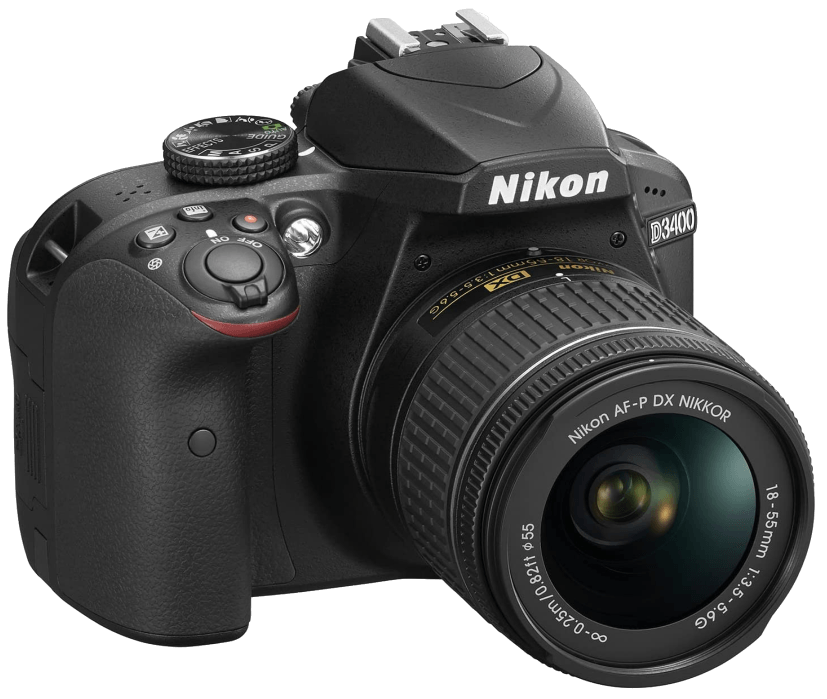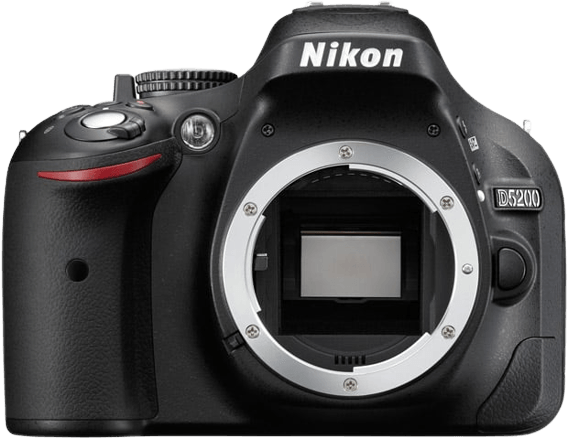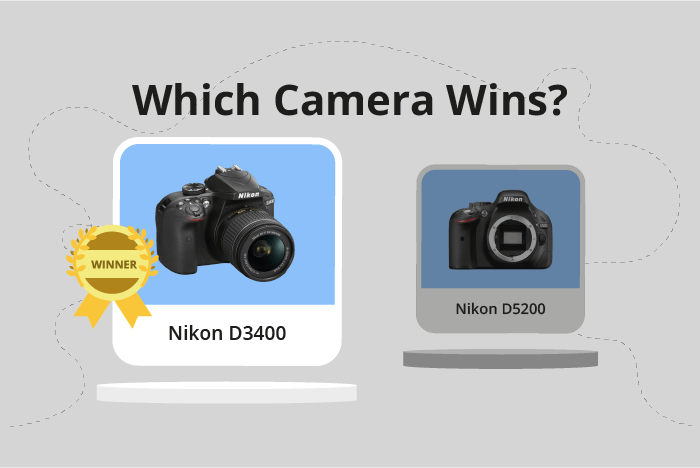Nikon D3400 vs D5200 Comparison
Nikon D3400

Nikon D5200

The Nikon D3400 comes out ahead with a score of 61/100 compared to the Nikon D5200‘s 56/100. Both cameras are DSLRs, released in 2016 and 2012 respectively. They share similar dimensions, with the D3400 measuring 124 x 98 x 76mm and the D5200 at 129 x 98 x 78mm. The D3400 has an advantage in weight, being lighter at 445g compared to the D5200’s 555g.
Despite the D5200’s higher launch price of $897, the D3400 still manages to outscore it. This is due to its lighter weight and more recent release, offering improved technology. The D5200, however, does not seem to have any significant advantages over the D3400.
Considering the score difference and the specifications, the Nikon D3400 proves to be the better choice. Its lighter weight and newer technology make it a more appealing option, especially for those looking for an efficient and easy-to-use DSLR camera.
Nikon D3400 vs D5200 Overview and Optics
The Nikon D3400 and the Nikon D5200 both receive an optics score of 65/100, indicating that their optics performance is comparable. Both cameras share several specifications, such as 24.2 and 24.1 megapixels, a shooting speed of 5 frames per second, a CMOS sensor type, an APS-C sensor size, a Nikon F DX lens mount, and no image stabilization.
Despite the identical scores, the Nikon D3400 has some advantages over the D5200. With a DXOMARK sensor score of 86, the D3400 has a slightly better sensor performance than the D5200, which scores 84. Additionally, the D3400 features an Expeed 4 processor, which is an improvement over the D5200’s Expeed 3 processor. This means that the D3400 may offer better image quality and processing speed.
On the other hand, the Nikon D5200 does not have any significant advantages over the D3400 in terms of optics. The only minor difference is that the D5200 has 24.1 megapixels, which is slightly lower than the D3400’s 24.2 megapixels. However, this difference is negligible and unlikely to impact the overall image quality.
Based on the specifications provided, it is evident that the Nikon D3400 has a slight edge in optics performance over the Nikon D5200 due to its better sensor score and improved processor. However, the overall optics performance of both cameras is comparable, and users may not notice significant differences in image quality or performance. Therefore, the choice between these two cameras should be based on other factors such as price, additional features, and personal preferences.
Nikon D3400 vs D5200 Video Performance
The Nikon D5200 outperforms the Nikon D3400 in video capabilities with a score of 70/100 compared to the D3400’s 56/100. Both cameras share some common specifications, such as Full HD video resolution, maximum video dimensions of 1920 x 1080, and a maximum video frame rate of 60fps. However, there are specific aspects where one camera excels over the other.
The Nikon D5200 has a clear advantage with its built-in time-lapse functionality, which the D3400 lacks. This feature allows users to create stunning time-lapse videos easily, directly from the camera itself. This added functionality makes the D5200 a more versatile choice for those looking to capture a variety of video types, including fast-paced action and slow-motion scenes.
On the other hand, the Nikon D3400 does not offer any significant advantages in video capabilities over the D5200. Both cameras have the same maximum video resolution, dimensions, and frame rate. As a result, the D3400 does not stand out in terms of video performance when compared to the D5200.
In comparing the video capabilities of the Nikon D3400 and D5200, the D5200 emerges as the better choice due to its built-in time-lapse functionality. This feature adds versatility to the camera, making it suitable for various types of video capture. The D3400, while still offering decent video performance, does not provide any notable advantages over the D5200. Therefore, for those prioritizing video capabilities, the Nikon D5200 is the more suitable option.
Nikon D3400 vs D5200 Features and Benefits
The Nikon D3400 wins the features comparison with a score of 54/100, while the Nikon D5200 scores 41/100. Both cameras share some common specifications, such as a 3-inch screen size and a screen resolution of 921,000 dots. Neither camera has a touchscreen, GPS, or WIFI capabilities.
The Nikon D3400 surpasses the D5200 in terms of connectivity, as it includes Bluetooth functionality. This allows for a seamless connection between the camera and other devices, such as smartphones, tablets, or laptops. It makes sharing images and videos much more convenient and efficient.
On the other hand, the Nikon D5200 has one advantage over the D3400, which is the presence of a flip screen. This feature enables users to capture images and videos from various angles easily, making it more versatile for different shooting situations.
To sum up, the Nikon D3400 outperforms the D5200 in terms of features, mainly due to its Bluetooth connectivity. This advantage makes the D3400 more user-friendly and efficient when transferring files to other devices. However, the D5200 has the edge with its flip screen, providing more flexibility in capturing images and videos from different angles. While both cameras have their strengths, the Nikon D3400 emerges as the better choice in this features comparison.
Nikon D3400 vs D5200 Storage and Battery
The Nikon D3400 outperforms the Nikon D5200 in storage and battery with a score of 45/100 to 27/100. Both cameras share common specifications, such as having one memory card slot and accepting SD, SDHC, and SDXC memory cards. Neither camera offers USB charging capabilities.
The D3400 has a significant advantage in battery life, providing 1200 shots per charge with its EN-EL14a battery. In contrast, the D5200’s EN-EL14 battery only lasts for 500 shots. This difference allows the D3400 to capture more images before needing a battery replacement or recharge.
The D5200 does not have any distinct advantages over the D3400 in storage and battery capabilities. The lower score reflects its shorter battery life and lack of additional features.
Considering the storage and battery aspects, the Nikon D3400 proves to be a better option than the Nikon D5200, primarily due to its extended battery life. This advantage makes the D3400 more suitable for longer shooting sessions or situations where charging opportunities are limited.
Alternatives to the Nikon D3400 and D5200
Are you still undecided about which camera is right for you? Have a look at these popular comparisons that feature the Nikon D3400 or the Nikon D5200:

